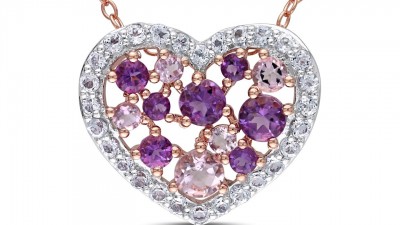When choosing a diamond for your jewelry, whether it is a ring or necklace, it is important to base your decision on 4 factors. These factors include shape, color, cut and clarity. You might also base your diamond purchase on the size, but this article will focus on the different shapes, colors, cuts and clarities so that you can make the right choice about your diamond based on important factors.
Shape:
There are many different shapes of diamonds, but only a certain few that are recognized and popular. You might already know what shape you want, but then you might go into the store and find a completely different shape that you never thought you would fall in love with, but do! Listed below are some of the most recognized shapes of diamonds:
Round- a circular shape
Princess- square-like shape
Emerald- rounded edges on a rectangle
Asscher- square-like shape
Marquise- oblong rounded shape with pointed top and bottom
Oval- oblong circle
Radiant- square-like shape
Pear- pear shaped, rounded on top and narrows down to a point at the bottom
Heart- shaped just like a heart
Cushion- rounded square-like shape
Jewelers grade diamonds from Z-D based on their color. A Z would have a yellowish color all the way up to a D, which is absolutely colorless. A more narrowed down list based on the color of a diamond is listed below:
Z-N- will show noticeable yellow/brown color
M-K- lighter yellow/brown color, noticeable as well
J-G- J will show some color all the way up to G which is virtually colorless
F,E,D- The best possible choices for a clear and colorless diamond
The cut of a diamond is actually the most important factor to look for when you are searching for your diamond. It is the most influential when it comes to the beauty of the diamond; it also determines how much “sparkle” the diamond has as well. Choosing the highest cut grade within your budget is much more important that the shape or color.
When a diamond is cut correctly, with perfect proportions, light will mirror out the top of it, if it is not deep enough or is too shallow, the light will go through the bottom instead and give off less “sparkle”. Shallow cut would go right through and give off virtually no sparkle at all, too deep and it will go off to the side or the light will be lost in it. The perfect cut, known as “ideal” will give off the best sparkle possible.
The cut is graded as follows:
Ideal
Very Good
Good
Fair
Poor
Fair, good and very good will all be pretty good diamonds and will be much less expensive than an ideal cut diamond, but poor cut should not be considered when you are looking for “sparkle”.
The last of the 4 C’s of diamond selection is Clarity. Clarity is the measurement of the size and number of any imperfections found on the diamond. Most of these are virtually invisible to the naked eye, but too many might cloud the diamond and interfere with its color and sparkle. Still some are microscopic and cannot be seen as affecting the look of the diamond.
These imperfections will be found in just about every diamond, finding a diamond that is in fact “flawless” is very rare and would be among the most expensive of diamonds, unless the cut and color were off.
Diamonds are rated on their clarity as follows:
FL, IF- Flawless and internally flawless, no imperfections at all and very rare
VVS1, VVS2- Very or Very slightly included, imperfections can be seen under 10x magnification, this is considered an excellent diamond.
VS1, VS2- Very Slightly included, not visible to the human eye normally and much less expensive than VVS1 and VVS2
SI1, SI2- Slightly included, imperfections can be seen under 10x magnification and could be seen to the naked eye, a good value for a diamond.
I1, I2, and I3- Included, imperfections can definitely be seen to the naked eye and this type of diamond will be very inexpensive but not worth it.
Jewelry Advice by Jewelrista.
Image Source 1.
Image Source 2.
Image Source 3.

































